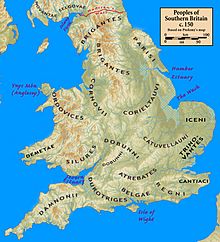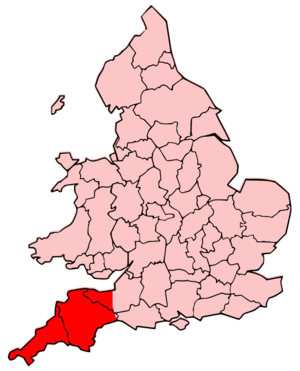Dumnonii facts for kids
Quick facts for kids Dumnonii |
|
 |
|
| Geography | |
| Capital | Isca Dumnoniorum (Exeter) |
|---|---|
| Location | Cornwall Devon West Somerset |
| Rulers | Kings of Dumnonia |
The Dumnonii were an ancient British tribe. They lived in the area we now call Cornwall and Devon. This was in the far southwest of Britain. They lived there from the Iron Age until the early Saxon period. Another tribe, the Durotriges, lived to their east.
Contents
What Their Name Means
The name Dumnonii likely comes from an old Celtic word. This word means "the deep" or "the earth." Some people think it might mean "deep valley dwellers." This idea comes from the Welsh word Dyfnaint, which is similar.
The Roman name for the city of Exeter was Isca Dumnoniorum. This means "Isca of the Dumnonii." Isca means "water," referring to the River Exe. The Dumnonii tribe gave their name to the English county of Devon. Their name is also seen in the modern Cornish word Dewnans and the Welsh word Dyfnaint.
Sometimes, old historians called them the Damnonii. But this is also the name of a different group of people in Scotland. There is no known link between the two groups.
Their Language
The Dumnonii spoke a Celtic language. It was similar to the old forms of Cornish and Breton. Some people from Ireland, called the Déisi, also came to live in Dumnonia. They left behind stones with special carvings called Ogham. These carvings help us learn about their language.
Where They Lived
A map from the 2nd century shows the Dumnonii living west of the Durotriges. Some records suggest there was a smaller group within the Dumnonii called the Cornavii or Cornovii. These might have been the ancestors of the Cornish people.
An ancient writer named Solinus wrote about them. He said that the Dumnonii lived near the Isles of Scilly. He noted that people on those islands used to trade goods instead of using coins. They also believed they could tell the future.
After the Romans left Britain, a British kingdom called Dumnonia formed. It covered the whole southwest peninsula. It might have been a group of smaller kingdoms working together. A similar kingdom, Domnonée, was also set up across the English Channel in France. This shows a possible old connection between the people on both sides of the sea.
Their Towns and Settlements
Isca Dumnoniorum (Exeter)
The Roman name for Exeter was Isca Dumnoniorum. This means "Water of the Dumnonii." It was an important town, or oppidum, on the River Exe. It existed even before the Romans built their city there around AD 50.
The Roman city grew around a fortress built by the Legio II Augusta (a Roman army group). This fortress was built between AD 55 and 60. The legion later moved to Gloucester around AD 68. After the army left, the site was used to build a public meeting place and a large hall. By the late 2nd century, the city had strong walls. However, by the late 4th century, the city started to decline.
Other Settlements
Besides Isca Dumnoniorum, other towns were mentioned in old texts:
- Voliba: We don't know exactly where this was.
- Uxella: This might have been on the River Axe or near Launceston.
- Tamara: This was likely somewhere on the River Tamar.
Other important places in Dumnonia included:
- Nemetostatio: This name means "sanctuary" or "sacred grove." It might be North Tawton in Devon, where there are Roman earthworks.
- Purocoronavis: This could have been an important hill fort like Carn Brea or Tintagel.
Other Roman-British sites were:
- Topsham, Devon – a port that served Exeter.
- Nanstallon (Cornwall) – a military camp linked to tin mining.
- Mount Batten (Devon) – an Iron Age tin port.
- Plymouth (Devon) – evidence of a Roman settlement.
- Ictis – an ancient port for trading tin.
New settlements continued to be built during the Roman period. These included places like Chysauster and Trevelgue Head. These settlements looked more like native British homes than Roman ones.
Archaeological Finds
Archaeologists have found many settlements from the Roman-British period in Dumnonia. Unlike other parts of Britain, Dumnonia didn't have many large Roman villas. Instead, people lived in isolated, enclosed farmsteads called rounds. These rounds continued to be used even after the Romans left. Later, in the 6th and 7th centuries, they were replaced by open farms.
Old Iron Age hill forts, like Hembury Castle, were made stronger. They were used by chiefs or kings. Other important places, like Tintagel, were also rebuilt. Archaeologists have found pottery from the Mediterranean and other distant places. This shows that Dumnonia traded with far-off lands.
What They Made and Traded
Besides farming and fishing, the Dumnonii's main resource was tin mining. People had been mining tin in this area since the Bronze Age, around 2200 BC. Tin was sent out from an ancient port called Ictis (St Michael's Mount).
Over time, tin trade became more organized. Traders from the eastern Mediterranean, like the Phoenicians and Greeks, came to buy tin. The tin was taken across the Bay of Biscay to France. From there, it traveled through rivers and then by sea to the Mediterranean.
Around 500-450 BC, tin became even more important. Fortified settlements like Chun Castle and Kenidjack Castle were built to protect the tin mines and smelters.
The earliest written account of Cornish tin mining was by Pytheas in the 4th century BC. He described underground mining, but we don't know when it started. Tin working continued during the Roman time. Even though new tin sources were found in Spain and Portugal, Dumnonia's tin production grew again in the 3rd century AD.
Dumnonia After the Romans
The history of Dumnonia after the Romans left is quite complex. We learn about it from many old writings. These include ancient Welsh and Latin texts. They mix historical facts with legends and old stories. This makes it hard to know exactly what happened during this time.
See also
- Cornovii (details of the three tribes bearing the name)
- Damnonii (tribe in central Scotland)
- Dark Ages (historiography)


